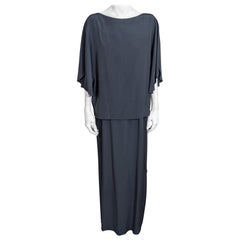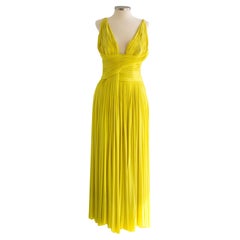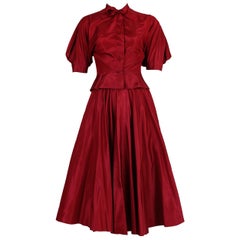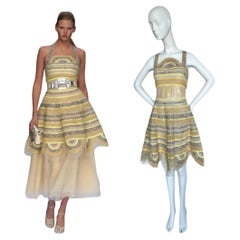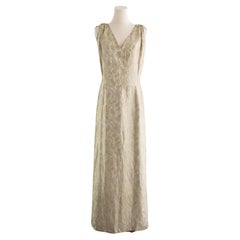Madame Gres
Forever credited with having altered the fashion world with her pleated silk dresses, Madame Grès was one of the greatest couturiers of the 20th century. She defied the orders of Nazi soldiers and designed gowns and evening dresses that mirrored the colors and pattern of the French flag, working by hand with material that hung directly from live models. A consummate artist, Grès created garments that were demonstrative of exemplary construction and meticulous attention to detail — her signature floor-length gowns left a lasting impact on every aspect of haute couture.
Born Germaine Émilie Krebs to a French Jewish family in Paris, Grès initially studied painting and sculpture. For her, making dresses and working in sculpture were one and the same, and she pursued a career in fashion. Grès worked in millinery and was trained in haute couture dressmaking at the illustrious House of Prémet.
Grès opened her inaugural couture fashion house in 1932, and within a couple of years she began working under the name Alix Barton — the surname came from her coworker, couturier Julie Barton — calling her business La Maison Alix and creating gowns until 1942 in what became her signature style. She perfected modern pleating techniques and worked directly on live models, mostly with generous amounts of silk jersey and airy silk paper taffeta. Her designs showed the influence of Greco-Roman sculpture and would go on to help shape the work of Jean-Paul Gaultier, Jil Sander and Azzedine Alaïa, who also thought of haute couture as sculpture.
Grès’s work was photographed by the likes of Horst P. Horst, and her gowns for Jean Giraudaux’s play The Trojan War Will Not Take Place in 1935 established her as a leading designer, though Nazi occupation stalled her growth.
During WWII, Grès refused to design the utilitarian garb that German forces requested and instead made clothes using the colors of the French flag as her own act of rebellion. Ultimately, she was forced to close her boutique in Paris. The designer married Russian painter Serge Czerefkov, changed her name to Grès — which is how her husband signed his name — and fled to the Pyrenees before returning to establish her second couture house under her new name.
Madame Grès’s second maison was widely successful and attracted a long list of rich and powerful clientele ranging from movie stars to royalty. A single dress could take hundreds of hours to complete. Some of the couturier’s clients became deeply loyal over the course of her career, including the Duchess of Windsor, Oscar-winning actresses Grace Kelly and Greta Garbo, iconic Tiffany & Co. jewelry designer Paloma Picasso and former First Lady Jacqueline Kennedy. Grès guarded her personal life closely and let her delicate, impeccable work speak for itself.
Original Madame Grès evening dresses and gowns, coats, jackets and day dresses, which transformed women into Greek deities, are held in the collections of the Metropolitan Museum of Art, the Museum at FIT and the Musée Bourdelle.
“Her dresses were about a sense of power, strength and beauty, not objectification,” explains Patricia Mears, deputy director of the Museum at FIT and author of Madame Grès: Sphinx of Fashion. “Everyone knows Chanel, Dior and Saint Laurent,” Mears says, “but I believe that the great triumvirate was Madeleine Vionnet, Balenciaga and Madame Grès — those who knew how to make clothes with their own hands, couturiers in the old sense of the word.”
Find vintage Madame Grès clothing and accessories on 1stDibs.
